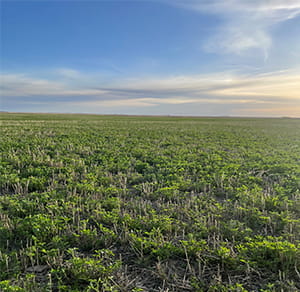By Brett Gaube, AAg, Range Management Extension Specialist, Weyburn
February 2024
Tame Forage Seeding
Tame forage lands are plotted, seeded and managed for grass and legume species. Establishing tame forage is an investment that requires thoughtful long-term planning, preparation and regular maintenance. The establishment is key to productivity and sustainability. In Saskatchewan, establishment recommendations vary by soil zone (brown, dark brown, black or grey) to include seeding rates. Different equipment can be used depending on the species and soil type.
Before seeding, there are a few key factors to consider. What is your intended end use? Will you be grazing the stand or cutting it for hay/silage? Do you intend to keep the stand long term or are you looking at a short-term rotation? Field characteristics, such as soil type (sandy, clay, salinity) and soil moisture can also impact species selection. Seeding too deep (ie. greater than one inch or 2.5 cm) can significantly reduce emergence for most forage species.

Forage Seeding Timing
The ideal time for seeding is generally in the spring. In most areas, early-spring seeding produces the best results because adequate moisture is usually available, temperatures are conducive for germination and weed pressure may be limited. The exact time to seed will be different throughout the province depending on the climate and condition of the soil.
If conditions are not favourable to spring seeding, then summer or fall seeding may be an option. In late summer, moisture is one of the most important factors in successful germination and establishment of forage crops. Adequate moisture is needed to promote sufficient root development before the ground freezes.
For dormant seeding in the fall, timing is crucial to ensure the seeds stay dormant through the fall/winter seasons until spring. Seeding forage crops from October 15 until freeze-up generally ensures that germination will not occur until the following spring. The mean daily soil temperatures should be 5 C or less before fall seeding. Spring soil moisture conditions will likely be favorable due to the infiltration of moisture from melted snow.
Recommended Seeding Rates
In forages, the bulk seeding rate should be based on a desired seeding density. Seeding density refers to the number of seeds placed in a meter row when placed in the seedbed. This is expressed in pure live seed (PLS) according to pounds per acre or kilograms per hectare and is based on planting a predetermined number of live seeds per square foot to achieve a specific plant density.
Each species will require a different number of seeds per pound or kilogram. To find species-specific seeding rate recommendations, check out this interactive forage species selection tool, seeding rate calculator. This calculator provides the best options of a seed blend based on region and soil type.
Seeding rates should be adjusted when seeding into low-quality seedbeds, or areas with high or low moisture. Many factors can affect seed placement such as poor choice of seeding method, moisture and soil condition.
Tips for evaluating tame forage seeding success:
- New forage seeding is best evaluated by measuring the number of seedlings within a given area.
- Check several locations within a field to confirm the overall seedling establishment. Uniformity of the stand across the field is as important as plant density.
- If the number of established seedlings is too low for a successful stand, re-seeding into the existing seedbed may be required.
- Seedling establishment may be slower in times of drought, crop competition, or poor-quality seedbeds.
Establishing tame forage takes careful consideration, time and effort. There are obstacles in establishing a productive stand; however, these obstacles can be countered with well-prepared seedbeds and a properly adjusted seeding approach for the forage being seeded.
For more information on seeding forages or to learn about beneficial management practices under the Resilient Agricultural Landscapes Program, call the Agriculture Knowledge Centre at 1-866-457-2377 to be connected with your local ministry specialist.
